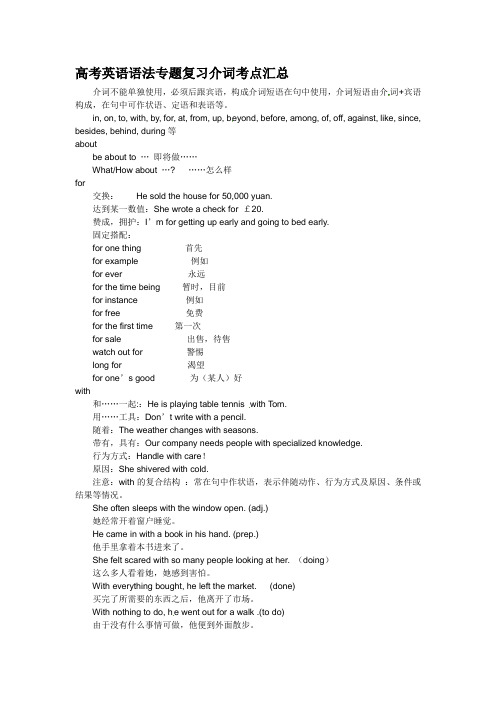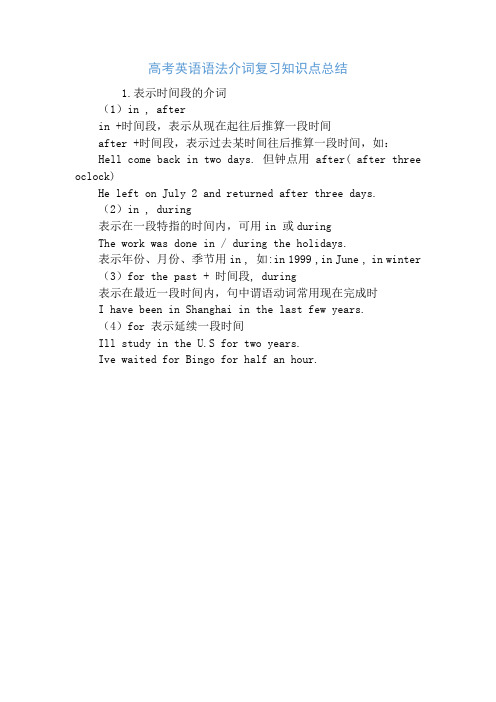(新)高考英语语法介词考点
- 格式:doc
- 大小:82.50 KB
- 文档页数:7

高考英语语法专题复习介词考点汇总介词不能单独使用,必须后跟宾语,构成介词短语在句中使用,介词短语由介词+宾语构成,在句中可作状语、定语和表语等。
in, on, to, with, by, for, at, from, up, beyond, before, among, of, off, against, like, since, besides, behind, during等aboutbe about to …即将做……What/How about …?……怎么样for交换:He sold the house for 50,000 yuan.达到某一数值:She wrote a check for £20.赞成,拥护:I’m for getting up early and going to bed early.固定搭配:for one thing首先for example例如for ever永远for the time being 暂时,目前for instance 例如for free免费for the first time 第一次for sale出售,待售watch out for警惕long for 渴望for one’s good为(某人)好with和……一起::He is playing table tennis with Tom.用……工具:Don’t write with a pencil.随着:The weather changes with seasons.带有,具有:Our company needs people with specialized knowledge.行为方式:Handle with care!原因:She shivered with cold.注意:with的复合结构:常在句中作状语,表示伴随动作、行为方式及原因、条件或结果等情况。
She often sleeps with the window open. (adj.)她经常开着窗户睡觉。

2023年高中英语语法知识精讲:常用介词考点分析一、shoot to, shoot at 及其他有网友问:在语法书和教辅书上,读到有关shoot to和shoot at 的区别,都说shoot to用于距离远、体积大的物体;shoot at用于距离近、体积小的物体。
请问,是这样的吗?这种说法很牵强,属于只看到现象,未触及本质。
用shoot to 还是shoot at与物体的远、近、大、小,没有直接的关系。
以下是我的理解和看法:shoot作“射击”讲,既是及物动词,也是不及物动词。
及物时表示“射中”,如:shoot the tiger(射中老虎);不及物时,跟不同介词搭配有不同的含义,例如:shoot at the wolf 朝着狼射击shoot to the woods 朝着森林方向射击shoot into the house 朝房内射击通过比较,我们发现:shoot本身没有变化,差别就在于,不同的介词有不同的含义。
at 表示“目标”;to表示“方向”;into表示“朝…….里面(有容积的物体)”。
所以,它们的区别与射击目标的“远、近、大、小”没有直接关系。
比方说,“朝着东方射击”,就用shoot to,因为to 表示“方向”,这时不能用at;wolf是目标就用at,但woods用at 就不合适。
类似的用法,也适应于look,point等词,请读者仔细体味:look at the blackboard (看黑板)look to the west(向西看)look into the water(向水里望去)point at the picture (指着图片)point to the wall (朝墙的方向指去)point into the sky(向空中指去)during the night与in the night的区别有朋友在本站“答疑中心”询问 during the night 与 in the night 的用法区别。

单句语法填空1.In many places like Britain and Italy, if you leave the house without your wallet, you’ll be a difficult situation all day.in解析:句意:在很多像英国和意大利这样的地方,如果你没带钱包就出门,你整天都会处于困境之中。
in a(n)...situation意为“处于某种处境”,为固定搭配。
2.Meanwhile, those who are successful and famous have to deal with constant media attention. They are also huge pressure to appear young and beautiful.under解析:句意:同时,那些成功人和名人不得不应对媒体的持续关注。
他们也处于保持年轻漂亮的巨大压力中。
under pressure 是固定短语,意为“处于压力中”。
3.The theory of kung fu is based classical Chinese philosophy(哲学).on/upon解析:base...on/upon...为固定搭配,意为“建立在……基础上”。
4.The city looked almost the same as it had looked in A.D. 79. There were streets and fountains, houses and shops. There was a stadium 20,000 seats.with解析:句意:这座城市看起来与公元79 年的样子几乎相同。
有街道和喷泉,房舍和商店。
有一个有两万个座位的体育馆。
空格处用介词with 表示“有……”,作后置定语修饰stadium。
5.Nowadays, the development of technology, online shopping is becoming more and more convenient.with解析:考查介词。


高考英语语法介词复习知识点总结
1.表示时间段的介词
(1)in , after
in +时间段,表示从现在起往后推算一段时间
after +时间段,表示过去某时间往后推算一段时间,如:
Hell come back in two days. 但钟点用after( after three oclock)
He left on July 2 and returned after three days.
(2)in , during
表示在一段特指的时间内,可用in 或during
The work was done in / during the holidays.
表示年份、月份、季节用in , 如:in 1999 ,in June , in winter (3)for the past + 时间段, during
表示在最近一段时间内,句中谓语动词常用现在完成时
I have been in Shanghai in the last few years.
(4)for 表示延续一段时间
Ill study in the U.S for two years.
Ive waited for Bingo for half an hour.。

专题介词和介词短语以及八大考点介词是一种用来表示词与词、词与句之间的关系的虚词,在句中不能单独作句子成分。
通常和名词,动词,形容词连用,介词后面一般有名词、代词或相当于名词的其他词类,短语或从句作它的宾语。
介词和它的宾语构成介词词组,在句中作状语、表语、定语或宾语补足语。
介词可分为时间介词、地点介词、方式介词、原因介词和其他介词。
介词的分类最常见介词一----in, on, at1.表示时间的at,in,onat表示片刻的时间(点),如:at 8 a.m. 常用词组有:at dawn, at noon,at night,at midnight,at the end of,at that time,at Christmas,at New Year等。
in表示一段时间(段),如:in the morning/afternoon/evening,in October,in 1998,in the 21st century, in summer, in the past, in the future等。
on指特定的日子(日),时间:on Monday,on Christmas Eve, on May Day,on a warm morning, on September 12, on that day等。
2.表示方位的at, in,onat表示“在某一点上” look at sb arrive at. Smile at, point at. At the top of ..... at the beginning of.......in表示“在…内”,Beijing is in the north of China.in the classroom. In the world. In Fangshan. in your heart, in your letter.on指“在....上, 与…接壤,在河/江畔”,Korea lies on the east of China. On the third floor. On foot. On your face. Put on your coat.二.表示“穿过……”的through, over和acrossthrough 指在内部穿过, across则指在表面上的横穿, over指在上方过去,跨越。
考点04 介词和介词短语高考频度:★★★★★【命题解读】介词在英语中比较活跃,在高考中,对介词的考查主要集中在语法填空和短文改错题型中,考查点为常见介词如,from,to, on, in, with, by, at, of , on 等等的基本用法上。
语法填空中介词的考查形式为非提示词型,短文改错中介词的考查包括介词的误用以及多词少词。
【命题预测】预计2021年高考对介词的考查将不再局限于单个介词,将会更加注重对介词基本用法和固定搭配中的介词的考查。
在短文改错中,主要考查对介词的误用。
【复习建议】1. 掌握主要介词的常见用法及易混介词的辨析;2. 掌握介词与其他词所构成的一些固定短语;3. 掌握在定语从句中介词的使用情况。
介词的分类考向①介词短语的功能介词不能独立在句中做成份,介词后必须与名词、代词、或动名词构成介词短语在句中充当一个成分,表示人、物、事件等与其它人、物、事件等之间的关系。
考向②常考介词的辨析介词是英语中最活跃的词类之一,使用频率相当高,其用法跟冠词一样复杂。
但根据近年来高考命题的情况来看,考生需要掌握以下内容。
1.表示相同或相似概念的介词(短语)的区别①at 8 o’clock, at noon②in the 1990s, in January③on Monday, on a warm morningon the①The lamp stands in the corner of theroom.②I me t with him at the street corner.③He sat on the corner of the table.besidesexceptbutexcept for1.(2020·新课标I卷短文改错)After that I poured oil into a pan and turned off the stove,I waited patiently unless the oil was hot.【答案】将off改为on【解析】考查介词。
代词、介词和介词短语考点01 代词1.(2024年浙江卷1月·语法填空)Who knows, perhaps some of the more forward-looking ________ (one) may yet come out with a whole range of “just for you” pack sizes with special offers as well.【答案】ones【解析】考查代词。
句意:谁知道呢,也许一些更有远见的人可能还会推出一系列“只为你”的包装尺寸,并提供特别优惠。
代词one意为“一个人”,在some of后应用复数形式。
故填ones。
preserved for all people of the nation to enjoy-as a national park.【答案】its【解析】考查代词。
句意:这个地方,以其独特而令人惊叹的自然美景,必须被妥善保存供全国人民欣赏。
这里“它们”用形容词性物主代词做定语修饰名词beauty。
3.(2023年全国甲卷改错)In that class, Miss Zhao, our biology teacher, showed we insects on stamps.【答案】we→us【解析】考查代词。
句意:在那节课上,我们的生物老师赵老师给我们看了邮票上的昆虫。
作动词show的宾语,应用宾格us。
故we改为us。
4.(2023年全国乙卷改错)Last Friday my mom decided to color his hair. She studied with all the hair products at the drugstore.【答案】his → her【解析】考查代词。
句意:上周五,我妈妈决定染头发。
此处指“我妈妈染她的头发”,应用代词her。
故his 改为her。
5.(2022年北京卷语法填空)Since people can’t always eat out or cook for ________ (they), they get takeout or order delivery.【答案】themselves【解析】考查反身代词。
高考英语语法介词考点介词是一种用来表示词与词、词与句之间的关系的虚词,在句中不能单独作句子成分。
介词后面一般有名词、代词或相当于名词的其他词类,短语或从句作它的宾语。
介词和它的宾语构成介词词组,在句中作状语、表语、定语或宾语补足语。
介词可分为时间介词、地点介词、方式介词、原因介词和其他介词。
①Nothing in the world could live without air or water.(状语)②This machine is in good condition.(表语)③Where is the key to my bike?(定语)④She always thinks herself above others.(宾补)一、介词的分类(1)从用法分类(2)从结构分类【考点一】考查with/without复合结构介词with/without+名词/代词+形容词/副词/介词短语/动词不定式/分词(分词可以是现在分词,也可以是过去分词)在句中表状态或说明背景情况,常作伴随、方式、原因、条件等状语。
With all the things she needed bought, she went home happily.Possibly this person died without anyone knowing where the coins were hidden.单项填空①It was a pity that the great writer died _____ his works unfinished.A. forB. withC. fromD. of解析:选B。
考查with复合结构。
works 与unfinish之间为动宾关系,所以用过去分词表示被动。
如果名词或代词与后面的动词是主谓关系,则用现在分词表示主动。
【考点二】考查工具、手段、方式介词(1)by, in, on三词都可表示旅行的方式①不涉及交通工具的名词时用by,名词前不加冠词。
如by sea, by water, by land, by rail, by air等。
②涉及交通工具的名词时用by,名词须用单数形式,前面不加冠词或任何修饰语。
如by bike, by taxi, by plane, by ship/boat, by train, by spaceship等。
③当旅行方式涉及确定特指的交通工具时,用on或in,名词前加冠词、物主代词、指示代词等修饰语。
如travel to New York in this plane,leave on an early train,go to school on my bike等。
注意:步行、骑马、骑骆驼均用on。
如on foot,on horseback,on a horse,on the camel。
(2)with, by, in三词均意为“用”,表示行为的工具、手段或方式。
①with用于有形的工具或身体某些器官之前,其后的名词多被冠词、物主代词等修饰。
They are digging with a pick/spade.We see with our eyes, hear with our ears, and walk with our legs.②by, in, on, over, through等介词多用于无形的工具或方式手段之前。
如by hand, in ink, on the telephone, over the radio, through the telescope等。
注意:①使用语言、原料、材料时,用in表示,如in English/Japanese;in blue ink等。
②表达“用……方法/式”时,所用介词有:in this/that/the same way,by means of,by this/that means,with this/that method等。
【考点三】考查of+抽象名词的用法“of+抽象名词”的用法与形容词相同,在句中可作表语、定语、补语。
of+great/much +抽象名词=very+名词的形容词形式of+no+抽象名词=not+名词的形容词形式It is of great value.=It is very valuable.It is of no use.=It is useless.The camel is of great help to the Arab.=The camel is very helpful to the Arab.【考点四】考查表示程度的介词by, to, beyondby 表示“增加了……”;to表示“增加到……”;beyond表示“范围, 限度超出”。
This new model of car is so expensive that it is beyond the reach of those with average incomes.单项填空②Sorry, Madam. You’d better come tomorrow because it’s ______ the visiting hours.A. duringB. atC. beyondD. before解析:选C。
考查介词的用法。
句意为:对不起,女士,你最好明天来,因为已经过了开放时间了。
beyond(时间)晚于,迟于。
【考点五】考查介词but的固定搭配have no choice but to do只得做某事;can’t help but do不得不做……;can’t but do不得不只能;can’t choose but do只得做某事;but for要不是……。
I have no choice but to accept his conditions.There was no taxi that day, I couldn’t choose but stay there foranother night.【考点六】考查to one’s+情感类名词to 与情感类名词连用,表示“某人因某事的发生而唤起其内心的某种情感”。
常见的结构有:to+one’s+delight/surprise/horror/sorrow/joy/regret=to the delight/surprise/horror/sorrow/joy/regret of sb.。
这种结构表示结果,用作状语,通常置于句首,也可置于句中或句末。
若要加强该结构的语气,有两种方式:①在名词前加great, deep 等形容词修饰;②在整个短语前加副词greatly, much等修饰。
To his disappointment, he failed again.【考点七】考查名词与to构成的固定搭配key, approach, solution, answer, entrance, visit, attitude等与to构成固定搭配:the key/approach/solution/answer/entrance/visit/attitude to...。
It is said that they have adopted a new approach to teaching English.【考点八】考查介词by的用法(1)by+地点名词。
表示方位,意为“在……旁边”。
注意:表示“从……旁边经过”时,多与动词go/walk/pass等词连用。
(2)by+时间名词,意为“到……时(已发生某事);最晚,不迟于……,在……之前”,此时谓语多用完成时。
(3)by+名词。
可用来表示方法、方式、手段等。
①by+the+可数名词(时间、长度、重量等),意为“按……计算;按……买(卖)”。
②by+表示时间、长度、重量等总称的不可数名词(名词前不加冠词),意为“按……计算,按……买(卖)”。
③by+表示交通工具、交通方式名词(名词前不加冠词,不用复数),意为“通过……;由……;乘……”。
④by+抽象名词或具有抽象意义的普通名词(名词前不加冠词,不用复数),意为“靠……;通过……;由……所致”。
⑤by+地点或工具等具体名词。
表示路线、途径,意为“通过(某物、某地);取道……”。
⑥by+动词-ing,意为“通过……;靠……;凭……”。
(4)by+数量词。
①表示升降、增减的程度。
②表示距离和面积、体积中的尺寸及乘除法中的运算。
(5)by+身体部位/衣服类名词。
表示被抓住身体/衣物的某一部分,常与catch/seize/take/hold/grab等动词连用。
It takes a long time to go there by train; it’s quicker by road.The man entered the room by the back door.The demand for organic food is increasing by about one third every year.Milk is sold by the pint, butter by the pound, and eggs by the dozen.1. Sean has formed the habit of jogging ______ the tree-lined avenue for two hours every day. (2010·上海)A. betweenB. alongC. belowD. with解析:选B。
考查介词的用法。
句意为:Sean已经形成了每天沿着绿荫大道慢跑两小时的习惯。
along沿着;顺着。
2. My father warned me _______ going to the West Coast because it was crowded with tourists. (2010·天津)A. byB. onC. forD. against解析:选D。
考查介词的用法。
句意为:父亲警告我不要去西海岸,因为那里挤满了游客。
warn sb. against doing sth.相当于warn sb. not to do sth.,表示“警告某人不要干某事”。
3. Tired, Jim was fast asleep with his back ______ a big tree.(2010·四川)A. inB. belowC. besideD. against解析:选D。
考查介词的用法。
句意为:累坏了,吉姆背靠着一棵大树,很快就睡着了。
against倚着,靠着;below在……下方;beside在……旁边;in在……里面或(时间)……之后。